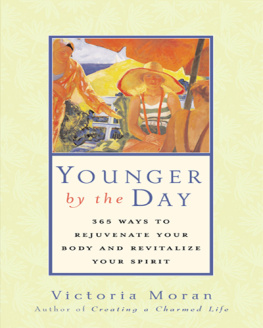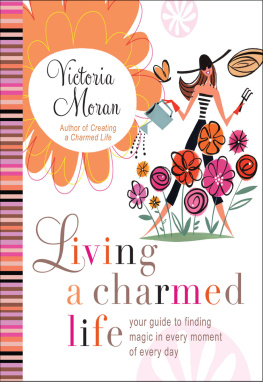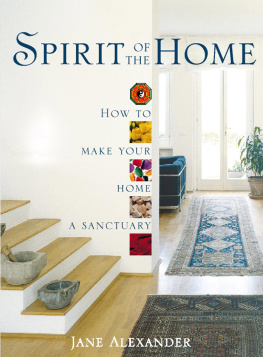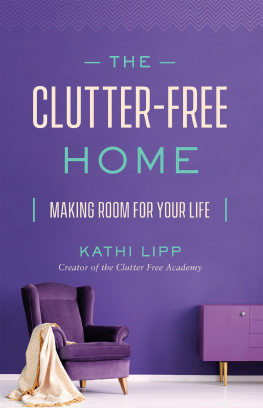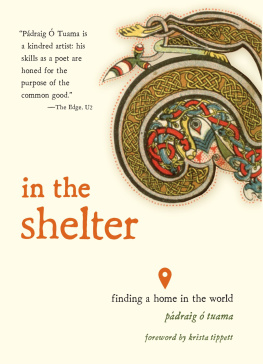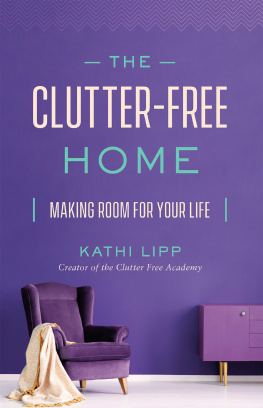Lit from Within: A Simple Guide to the Art of Inner Beauty
Living a Charmed Life: Your Guide to Finding Magic in Every Moment of Every Day
"Fat, Broke & Lonely No More"
"Creating a Charmed Life: Sensible, Spiritual Secrets Every Busy Woman Should Know"
Fit from Within: 101 Simple Secrets to Change Your Body and Your Life
Shelter for the Spirit: Create Your Own Haven in a Hectic World
Younger by the Day: 365 Ways to Rejuvenate Your Body and Revitalize Your Spirit
To my family and my extended family
W e live in a time when the ordinary life is more elusive than the extraordinary. Some days Im overcome by feelings of nostalgia for the days when people seemed deeply and satisfyingly engaged in their ordinary activities. Today we seem hungry for new information, extraordinary salaries, and celebrity of every description. Even the average person tries to share, if only partially, in the excitement of these wonders. Something in the human imagination clearly enjoys the thrill of the extraordinary, but something else deep in the soul is profoundly pleased and calmed with everyday, humdrum, unremarkable days and situations.
Often it appears to me that many of our problems stem from overlooking the importance of family, children, the land, the neighborhood, and home. As we seek out exotic teachers, books, and programs of personal growth, we are looking for meaning in all the wrong places. As we focus ambitiously on individual progress and enlightenment, our souls may begin to feel starved, and by then were convinced we need therapy or pills to deal with the resulting depression and other symptoms. The real problem may well be a simple lack of nourishment for the soul, which feeds best on things that nurture the heart and keep ordinary life vibrant.
This prescription is especially suited to feelings of insecurity that come along in almost every persons life. Given the temper of the times, we may think our disturbing sensations of insecurity may go away if only we understood them and then changed our personalities in appropriate ways. But insecurity may call for a more tangible response. What is it that makes us feel secure? Parents, friends, a familiar place, good work, and a real home go a long way toward establishing a secure life. Whatever can help us feel at home while on the job, traveling, or in the house can also offer a reassuring sense of being grounded and centered.
Its common knowledge that a house is not always a home and that a home is not always a house. We have to become adept at the heartfelt tasks of making a homethe art of designing, furnishing, maintaining, and living in a house. It may seem too simple to suggest that deep and debilitating anxiety can be cured by making a home, and some might think it unnecessary to teach someone how to live in a house. But in modern times humane living has entered the province of therapeutics, and the simple necessities are generally obscured by our focus on the sophisticated technologies that complicate our work and play.
I welcome this gracefully written book, full of wisdom and sensitivity to the deep home that can cure a troubled soul or make an ordinary life enchanted. Its helpful to listen to someone who has thought long and creatively on the everyday task of making the house a home and who can see the importance to the soul in the careful placing of objects and in centered cleaning and fixing. Ordinary chores satisfy primary longings, and in our time we need to be reminded of their importance.
Wired to the media, we may feel pulled out of our homes and onto the anxious staging of world history, but peace and humanity begin in a home that shelters the heart, the soul, and the spirit; where work and play enjoy a scope and proportion measured by a human scale. Our humanity is not abstract; it is made concrete by the emotional tone of our homes and the human scale of our living.
Shopping, cleaning, and ordinary housework may often feel like drudgery, but they also give pleasurea sign that they have a place of real significance in the life of the soul. Make our homes with heart and imagination, and a human culture will follow. But neglect the home, giving everything to wandering and adventuring, and the soul will complain in emotional and physical disturbances.
Early in my life I studied the demanding rules of logic and the often incomprehensible abstractions of philosophy. Now I take my pleasure and find traces of meaning in my family and my homeand in reading fine books such as this one that in graceful language show us the way home.
Thomas Moore
H uman beings need a place to foster an inner life. Shelter for the Spirit is about creating such a place from a house or apartment that used to be only a Tudor or a brownstone. It is about reclaiming home as the primary center for our spirituality, our resourcefulness, and the majority of the best moments of our lives. It is a guide to discovering sacred space in the midst of the ordinary, and to realizing that the ordinary has been extraordinary all along.
Home is so fundamental we tend to overlook the degree to which it affects our work, our well-being, and our overall effectiveness. As Margaret Visser writes, The extent to which we take everyday objects for granted is the precise extent to which they govern and inform our lives. When we are able to consciously experience and appreciate life at home and make changes there to enhance it when we can, we reap the benefits both when were home and when were not. Cleaning out a closet, eating in a little more often, snatching a few minutes alone in the morning to sit with our private plans and thoughts and feelingssuch small but specific actions increase the beauty, satisfaction, and peace of mind we experience.
If youre like me, you feel more in control of your life when your house is in order. You probably feel happier when objects of sentimental or aesthetic appeal populate your environment. When you have a place where friends easily congregate, you feel supported. When you know that there is some square footage in the universe set aside for you to be comfortable, creative, and leave a legacy with your name on it, you feel secure.
Ive learned what it takes for me to be happy at home from the places Ive livedthe London bed-sitter I rented at eighteen; modern complex apartments with balconies and trash compactors; and fine houses in their dotage with old wood and lead glass and gas lines behind the ceiling fixtures. Ive learned by being home a lot, as a homeschooling mother and a writer working at home, as well as by traveling for long stretches and needing to bring a sense of home along on the journeys. Ive also learned by observing the homes of others.
As a child, I did a lot of visiting. There were the suburban ranches of my mothers half dozen siblings, the cool stone and mahogany bungalows of my elderly nannys seemingly ancient friends, and the tiny tenement flats where I accompanied my father, a doctor, on house calls. The patients who lived there didnt have the money for a hospital stay, but some of them avoided hospitals on principle. Those are just places to die, I remember hearing from a tiny old woman who had once met Charles Lindbergh and could name the books of the Bible in order. If the Lord wants to take me, He can come and get me right here where I live.
Unconsciously I began to read those houses and apartments as a palmist would read the lines on a hand. Each dwelling revealed the character of its inhabitants well beyond their financial status or their taste in furniture. Each one had a personality. Sometimes the simplest were the best: They tended to have the most dogs and the most cookies.


